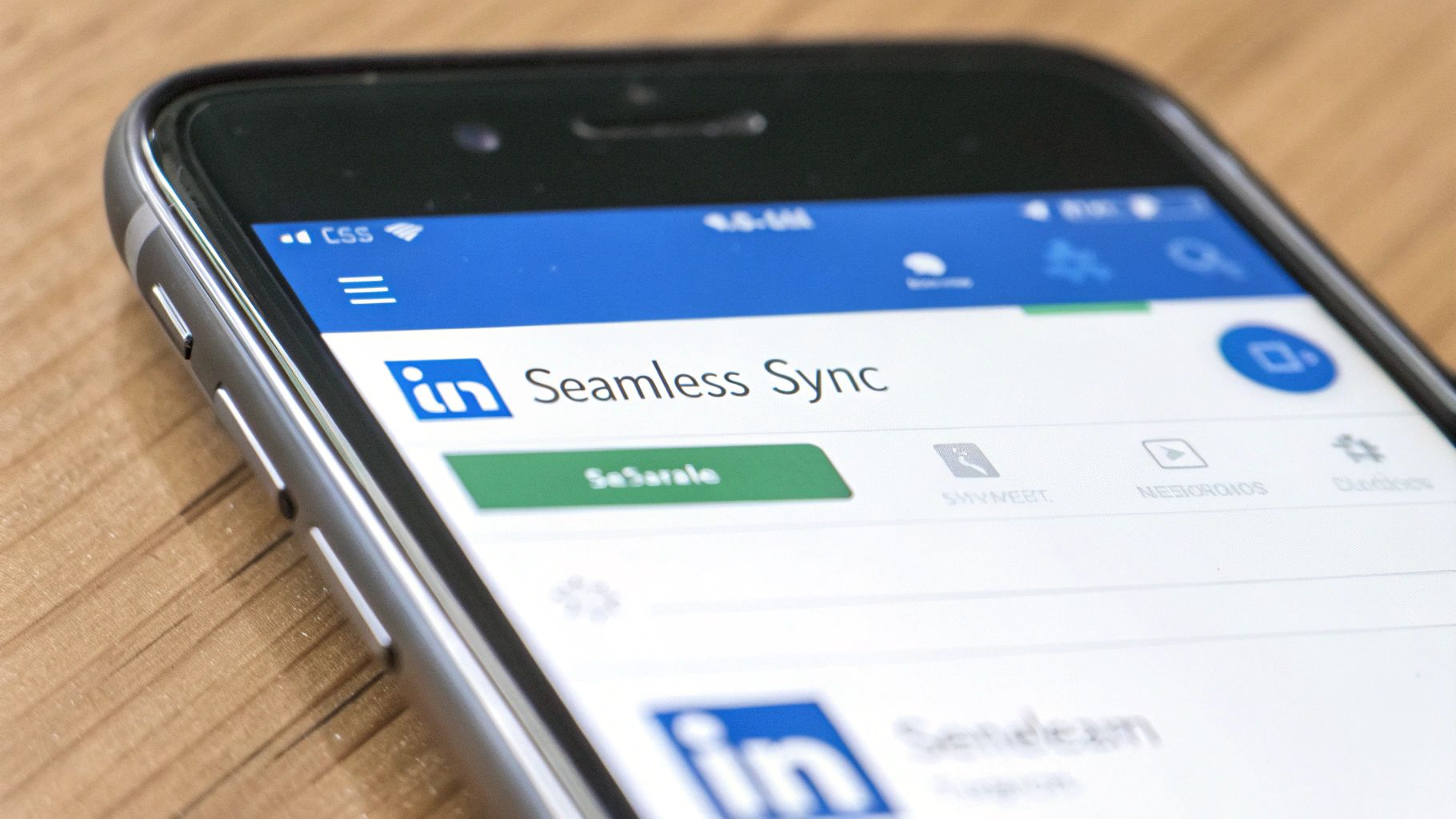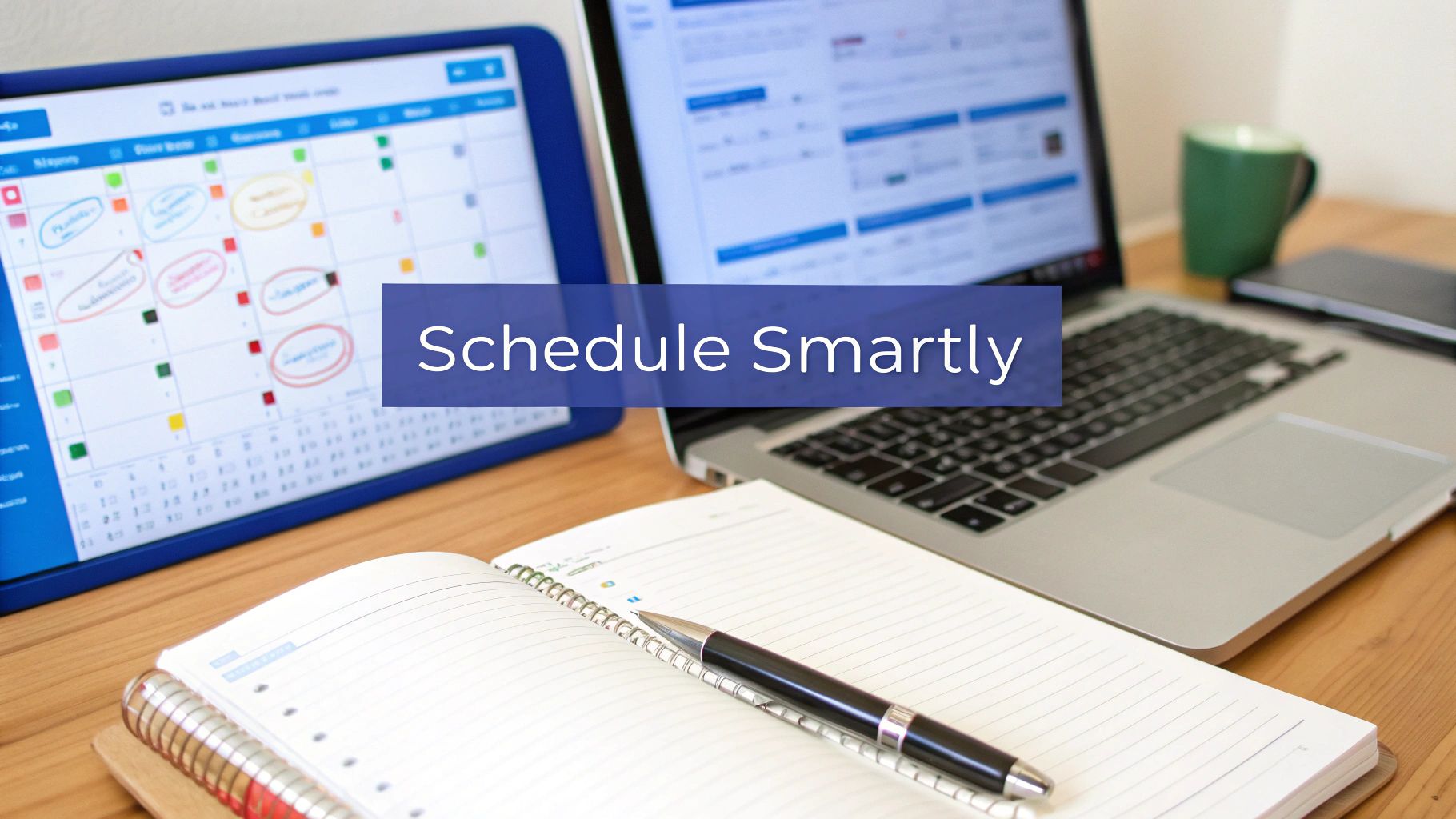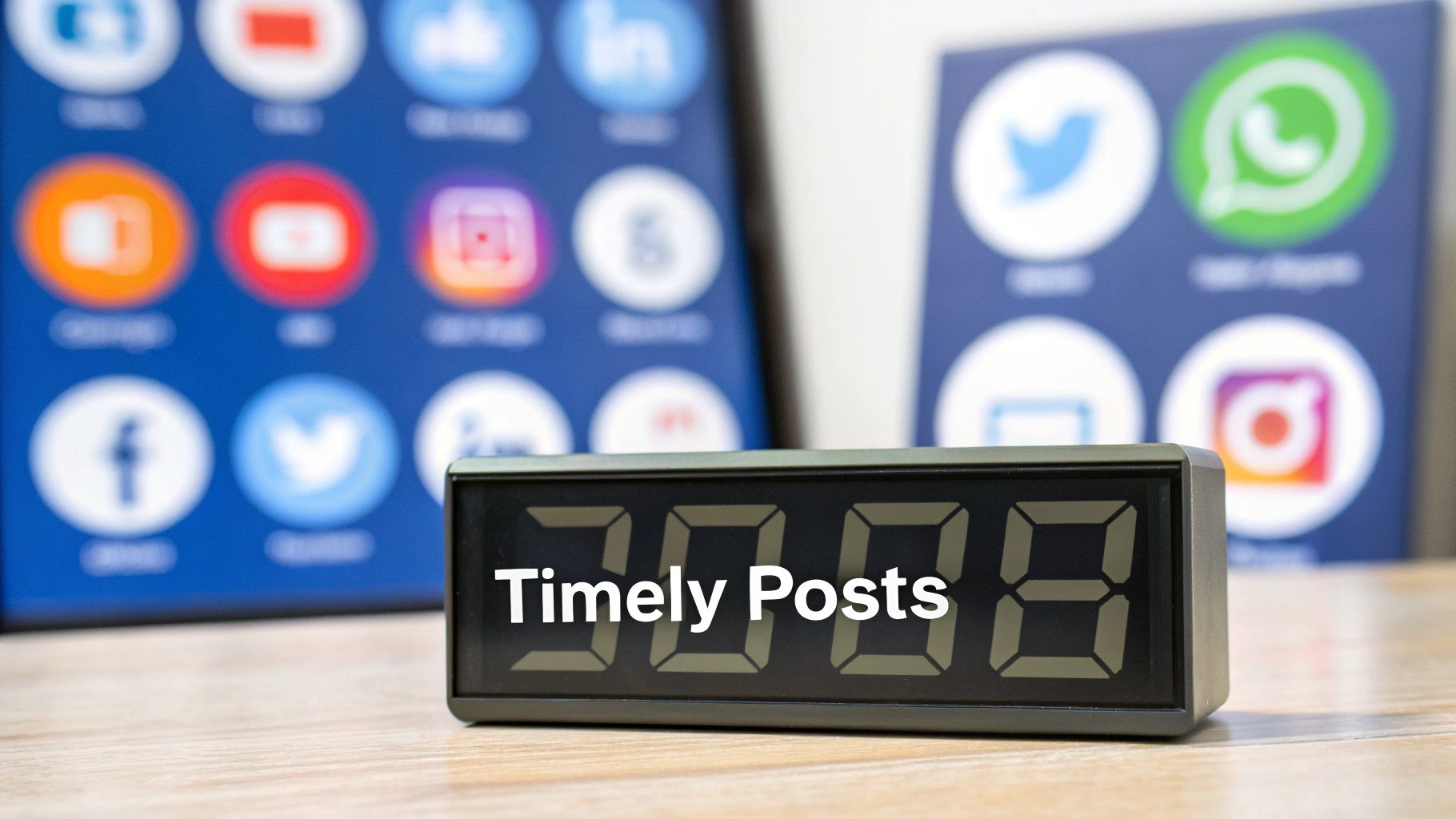The Ultimate Guide to LinkedIn Post Scheduling: Mastering Professional Social Engagement
The Ultimate Guide to LinkedIn Post Scheduling: Mastering Professional Social Engagement
Understanding the Power of Strategic LinkedIn Scheduling

Posting at the right time can make a big difference in how many people see and engage with your LinkedIn content. Just like a shop owner choosing their busiest hours to open, you need to post when your audience is most active. This is where scheduling your LinkedIn posts becomes really useful - it helps you stay consistent even when you're busy with other tasks.
Why Timing Matters on LinkedIn
LinkedIn users are most active during work hours, unlike other social networks. People typically check LinkedIn during their morning commute, lunch break, or when catching up on industry news. Posting at 9:00 AM tends to get better results than posting at 8:00 AM, since more professionals are starting their workday. You can learn more about optimal posting times in this guide: How Often to Post on LinkedIn. Regular posting also helps establish you as a reliable voice in your field.
The Benefits of a Strategic Scheduling Approach
Planning your LinkedIn posts ahead of time offers several key advantages:
- Keep Your Profile Active: Regular posts help you stay visible to your connections and showcase your expertise
- Reach More People: Posting when your audience is online increases your chances of engagement
- Save Time: Scheduling posts in advance lets you focus on other important work
- Build Your Brand: Well-timed, consistent posts help you become known in your industry
When you develop a solid LinkedIn posting schedule, you can grow your professional network more effectively. Regular posting creates momentum - as more people see and engage with your content, your reach naturally expands. This helps you build meaningful connections and establish yourself as a trusted voice in your professional community.
Crafting Your High-Impact Posting Schedule

Creating an effective content calendar on LinkedIn requires more than just randomly scheduling posts. You need to understand when your professional connections are most active and how to structure your content for maximum engagement.
Defining Your LinkedIn Goals
Start by getting clear on what you want to achieve. Are you focused on building your personal brand, getting B2B leads, or becoming known as a thought leader in your field? Each goal needs a different posting approach. For example, lead generation might require more direct call-to-action posts, while thought leadership needs in-depth analysis and expert perspectives.
Finding Your Optimal Posting Rhythm
Regular posting helps keep you visible to your network. According to LinkedIn, posting 20 times per month helps you reach 60% of your followers. This means posting once each workday. Want more insights? Check out these LinkedIn posting best practices. But remember - test different posting times and track your results to find what works for your specific audience.
Building a Sustainable Content Calendar
Quality matters more than quantity. Try creating content in batches and repurposing existing material to maintain consistent posting without burning out. For example, spend one morning writing several posts around a theme, then schedule them throughout the week. You can also turn your blog posts, presentations or reports into bite-sized LinkedIn updates.
Balancing Planned and Spontaneous Content
While having a content calendar is important, leave room for real-time engagement. Mix your scheduled posts with timely industry updates and responses to comments. Think of your calendar as a guide rather than a rigid schedule. This keeps your profile active and genuine while helping you connect with your target audience effectively. Tools like Twillie can help LinkedIn writers manage both planned and spontaneous content efficiently.
Mastering LinkedIn Analytics for Strategic Success

Understanding LinkedIn's analytics gives you clear insights to boost real engagement. By looking at key numbers and trends, you can schedule your posts when your audience is most active. Knowing when your followers are online helps your content reach more people and get better results.
Analyzing Audience Insights
LinkedIn's analytics tools show you exactly who your audience is and what they care about. You can see their age groups, where they're based, and what topics interest them most. This helps you create content they'll want to engage with. Learn more about getting the most from these tools on SocialBee's LinkedIn guide.
Beyond Surface-Level Metrics
Good LinkedIn performance isn't just about counting likes and shares. The real value comes from tracking click-through rates and engagement ratios to measure how your posts perform. Look at how your content helps achieve business goals like generating leads and improving return on investment (ROI).
Combining Data and Feedback
Numbers tell part of the story, but comments and messages from your audience complete the picture. Top brands mix hard data with direct feedback to shape their content strategy. When you understand both what the numbers show and what people say, you can create posts that consistently connect with your audience.
Best Practices for Analytics
Here's how to make the most of LinkedIn analytics:
- Track Engagement Trends: Note which posts get the most responses and do more of what works
- Monitor Audience Growth: Watch how follower counts change after different types of content
- Refine Based on Feedback: Use comments and messages to improve your content approach
Following these steps helps you match your posting schedule to when your audience is most likely to engage, leading to better results on LinkedIn.
Using Professional Tools for LinkedIn Success

The built-in LinkedIn scheduler has its limits. Many professionals, especially those who manage multiple accounts or client content, find that using high-quality scheduling tools makes a real difference in their social media work. These tools offer better features and simpler workflows that help save time and get better results.
Finding Your Perfect Tool Match
The best tool for you depends on what you need to do. Are you building your own personal brand, or writing posts for multiple clients? For example, if you write for clients, you'll want features that make working together easy. But if you're focused on your own brand, good analytics might matter more.
Must-Have Features
When looking at LinkedIn scheduling tools, keep these important features in mind:
- Better Scheduling Options: Look for tools that let you schedule recurring posts, upload many posts at once, and plan further ahead than LinkedIn's three-month limit
- Team Features: Tools with content calendars and approval systems help teams work better together
- Performance Tracking: Good analytics help you understand what works and improve your strategy
- Works with Other Platforms: The ability to connect with other social media accounts makes managing everything easier
A Look at Twillie for Writers
Twillie works particularly well for writers who create content for clients. It makes managing client content simple, speeds up the approval process, and shows all upcoming posts in a clear calendar view. This helps writers keep posts consistent and clients happy.
Getting Value from Paid Tools
While you have to pay for premium tools, they can be worth the investment. They save time by automating tasks, make work flow better, and provide useful data. This lets you focus on writing good content and building real connections. The tools can also help you reach the right audience at the right time, leading to more engagement. Think about how much time you save by scheduling many posts at once, or how helpful it is to see which posts perform best.
Making Tools Part of Your Process
Using scheduling tools well means more than just setting up posts. You need to fit them into how you already work. This might mean connecting your social media accounts, creating a clear process for content approval, and checking your results regularly to improve. When you use these tools as part of a complete approach to LinkedIn posting, you'll get better results.
Content Planning Strategies That Scale
Creating quality LinkedIn content regularly is challenging, especially when authenticity matters. But smart planning helps you produce more content while keeping standards high. Here's what successful LinkedIn creators do to scale effectively.
Smart Content Batching
Content batching helps you create multiple posts in one focused session. Set aside dedicated time - like a morning - to write several posts around one topic. This approach saves time and keeps your message consistent. Remember to review and refresh the content before posting to maintain a natural feel.
Using Templates Strategically
Good templates give structure while letting you customize each post. For example, use a storytelling framework with scene-setting, conflict, and key takeaways. This guides your writing while ensuring each post offers something unique to readers.
Setting Up Simple Workflows
A clear workflow helps you post regularly without rushing quality. Many creators use tools like Twillie to manage content calendars and approvals. This frees up time for other work while keeping content organized and on schedule.
Getting More From Your Content
Make your content work harder by adapting it for different formats. Turn a popular LinkedIn article into a video script or infographic. Just be sure to adjust the style for LinkedIn's professional audience and engagement patterns.
Finding the Right Balance
Regular posting builds authority, but quality still matters most. Keep your content plan flexible enough to include timely industry topics. Mix planned posts with spontaneous updates to stay engaging and relatable.
Remember: Good LinkedIn content planning means batching efficiently, using templates wisely, keeping workflows simple, adapting content smartly, and balancing consistency with quality. Follow these principles to grow your LinkedIn presence while staying authentic.
Measuring and Optimizing Your LinkedIn Strategy
For lasting success on LinkedIn, you need more than just scheduled posts. Understanding how your content performs and making data-driven improvements is essential. Let's explore how to measure results and refine your approach.
Identifying Key Performance Indicators (KPIs)
Match your metrics to your goals. For brand awareness, focus on impressions, reach, and follower growth. If you want lead generation, track click-through rates, lead form submissions, and website traffic from LinkedIn. For thought leadership, pay attention to comments, shares, and engagement rate to see how people interact with your posts.
A/B Testing Your LinkedIn Posts
Test different elements of your posts to find what works best. Try comparing:
- Text-only vs image vs video posts
- Different posting times and days
- Various hashtag combinations
For example, post similar content at 9 AM Monday and 11 AM Wednesday to see which time gets better results. Use these insights to guide your future posting schedule.
Understanding Your Audience
Look beyond basic numbers. Read through comments to understand what sparks discussions. Study the demographics of engaged users to better target your content. If you notice certain industries or job roles engaging more with specific topics, create more content that speaks to those audiences.
Measuring Business Impact
Connect your LinkedIn efforts to real business results. Use UTM parameters in your links to track website visits and conversions from LinkedIn. Monitor how many LinkedIn leads become customers. This data helps prove the value of your strategy and supports continued investment in the platform.
Ready to take control of your LinkedIn content? Twillie helps LinkedIn ghostwriters manage client posts, simplify content approval, and maintain a clear posting schedule. Start improving your LinkedIn strategy today!